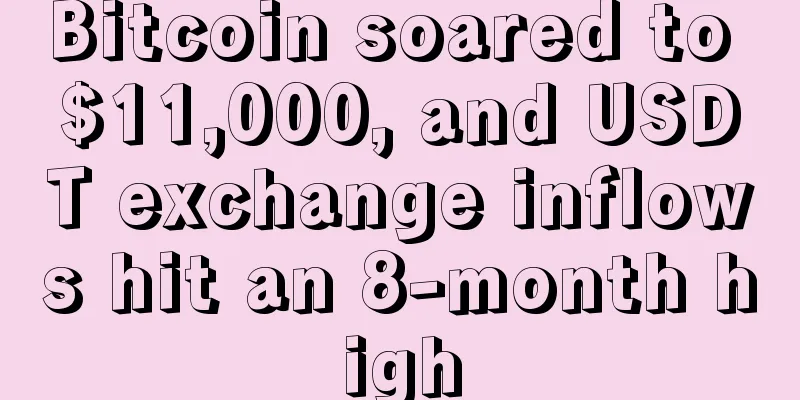Bitcoin soared to $11,000, and USDT exchange inflows hit an 8-month high

|
According to on-chain data provider Glassnode, Tether (USDT) exchange inflows have recently surged to their highest level in the past eight months. Yesterday, as Bitcoin (BTC) surged to $10,270, USDT exchange inflows reached a 2020 high, however, Bitcoin has continued to rise since then and is currently priced at $11,000. USDT exchange inflows Source: Glassnode While the research firm found that USDT held on exchanges has a negative correlation with Bitcoin prices, since USDT is the fastest and most popular way to acquire Bitcoin, USDT inflows can also be seen as a bullish sign for Bitcoin. USDT continues to develop in all aspects USDT has broken several records recently, recently surpassing Ripple (XRP) to become the third largest cryptocurrency by market cap, and even surpassing the $10 billion mark this month. Currently, USDT accounts for the majority of the total market cap of the stablecoin market, which recently also exceeded $12 billion. Not only has USDT’s market cap continued to grow (along with most of its USD-based competitors), but its trading volume has recently picked up. While USDT’s trading volume is still far from its all-time highs of March 2020, BTC/USDT trading volume has picked up over the past week, driven primarily by the surge in Bitcoin’s price. USDT-24-hour trading volume (BTC) Source: CryptoCompare A recent report from market and on-chain analytics firm Messari suggests that USDT alone may soon surpass Bitcoin as the dominant cryptocurrency in terms of daily transaction volume. This takes into account all USDT transferred across Ethereum, TRON, and the Omni layer, which is a colored coin protocol on the Bitcoin blockchain itself. The growth in value settled via USDT is also largely attributed to inter-exchange settlement and the decentralized finance sector. Daily transaction value of Bitcoin and Tether. Source: Messari Bearish outlook The recent surge in exchange inflows, along with all other indicators regarding USDT, could indicate a bullish outlook for Bitcoin. The growing market capitalization of USDT indicates demand for stablecoins, while the increasing exchange inflows indicate demand for Bitcoin and other cryptocurrencies. The additional demand for USDT may be attributed to the fact that only a few exchanges offer USDT-based derivatives to go long and short Bitcoin. However, according to CryptoCompare analyst James Li, the recent USDT exchange inflows observed by Glassnode may not have such a positive impact on Bitcoin prices if considered in isolation. Li told Cointelegraph: “Looking at the historical patterns in the chart alone doesn’t seem to send a bullish signal to me. Some previous large inflows were followed by price declines, while others had no impact on prices. The final price increase was after the big drop in March, but this time there was no drop before the price increase.” |
<<: How to improve Ethereum 2.0’s collateral mechanism to increase participation and reduce risk?
Recommend
Can the strongest spear, quantum computers, penetrate the strongest shield, cryptocurrency?
Millions of qubits are needed to crack cryptocurr...
As many as 800,000 Bitcoin miners shut down in the past two weeks
F2Pool, the world's third largest mining pool...
What is the fortune and personality of a person with a hanging nose?
Many times, facial features may be able to make a...
How to tell a person's personality from the wear and tear on the soles of his shoes when he walks
(1) The front of the shoe is damaged first. This ...
How to tell IQ from palm lines
Palmistry is a profound academic discipline. The ...
People who are good at making money look like this!
For many hard-working workers, their biggest wish...
Judging from the face, who has good fortune in wealth?
In life, why is it that some people work diligent...
How to read hip physiognomy
People in ancient times believed that women shoul...
From less than 100 yuan to thousands of yuan, Chengdu Bitcoin speculators made 5 times the profit in 3 years
"You ignored me yesterday, but now you can&#...
The Korean Accounting Institute plans to promote the "Digital Currency Accounting Standards". Bitcoin will be classified as a "current asset" and reflected in the financial statements.
According to South Korean media Business Korea, t...
What kind of women are difficult to get along with?
There are all kinds of people in our lives, and p...
A face you will remember after hearing it once
Nowadays, we see more and more people with abilit...
Will the next bull market opportunity be triggered by blockchain being brought under regulation?
2022 is almost over, and one can’t help but look ...
Physiognomy: facial features that can help you save money
Physiognomy: facial features that can save money ...
As personal abilities improve, desires also grow
Everyone has desires, but not everyone can satisf...









